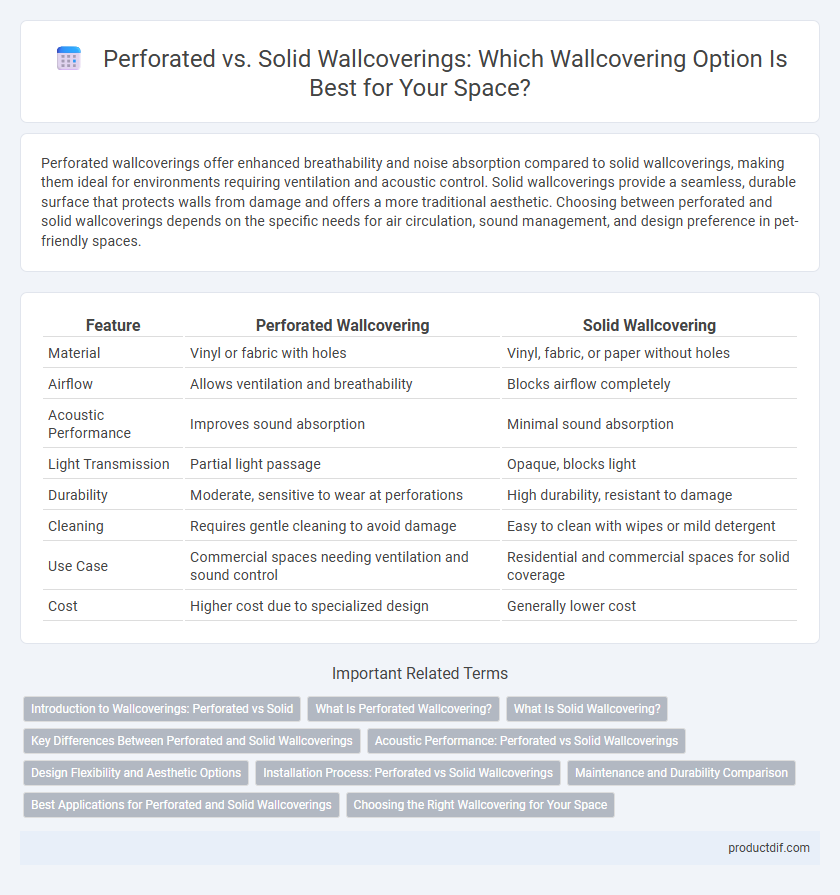Perforated wallcoverings offer enhanced breathability and noise absorption compared to solid wallcoverings, making them ideal for environments requiring ventilation and acoustic control. Solid wallcoverings provide a seamless, durable surface that protects walls from damage and offers a more traditional aesthetic. Choosing between perforated and solid wallcoverings depends on the specific needs for air circulation, sound management, and design preference in pet-friendly spaces.
Table of Comparison
| Feature | Perforated Wallcovering | Solid Wallcovering |
|---|---|---|
| Material | Vinyl or fabric with holes | Vinyl, fabric, or paper without holes |
| Airflow | Allows ventilation and breathability | Blocks airflow completely |
| Acoustic Performance | Improves sound absorption | Minimal sound absorption |
| Light Transmission | Partial light passage | Opaque, blocks light |
| Durability | Moderate, sensitive to wear at perforations | High durability, resistant to damage |
| Cleaning | Requires gentle cleaning to avoid damage | Easy to clean with wipes or mild detergent |
| Use Case | Commercial spaces needing ventilation and sound control | Residential and commercial spaces for solid coverage |
| Cost | Higher cost due to specialized design | Generally lower cost |
Introduction to Wallcoverings: Perforated vs Solid
Perforated wallcoverings feature small holes that enhance breathability and acoustic performance, making them ideal for spaces requiring sound absorption and airflow. Solid wallcoverings offer a continuous surface that provides durability, easy maintenance, and a seamless aesthetic. Choosing between perforated and solid wallcoverings depends on functional needs, such as ventilation and sound control, versus design preferences and surface protection.
What Is Perforated Wallcovering?
Perforated wallcovering features a pattern of small, evenly spaced holes that enhance acoustic performance by absorbing sound and improving room acoustics. Unlike solid wallcoverings, perforated designs allow for better air circulation and can reduce echo in spaces like offices and theaters. These wallcoverings are ideal for environments requiring both decorative appeal and functional noise control.
What Is Solid Wallcovering?
Solid wallcovering is a continuous material applied to walls without any perforations or holes, providing a smooth and uniform surface that enhances durability and visual consistency. It is commonly made from vinyl, fabric, or paper and serves as an effective barrier against moisture and stains, making it ideal for high-traffic or moisture-prone areas. Unlike perforated wallcoverings, solid wallcovering delivers superior insulation and soundproofing qualities, contributing to improved comfort and energy efficiency in interior spaces.
Key Differences Between Perforated and Solid Wallcoverings
Perforated wallcoverings feature small holes or patterns that allow for improved breathability and sound absorption, enhancing indoor air quality and acoustics. Solid wallcoverings offer a continuous, non-porous surface that provides superior durability, easy cleaning, and maximum privacy or light blocking. Choosing between perforated and solid wallcoverings depends on balancing ventilation needs with aesthetic preferences and functional requirements.
Acoustic Performance: Perforated vs Solid Wallcoverings
Perforated wallcoverings enhance acoustic performance by allowing sound waves to pass through and be absorbed by underlying materials, reducing echo and improving room acoustics. Solid wallcoverings provide a dense barrier that reflects sound, often leading to increased reverberation and less effective noise control. Choosing between perforated and solid wallcoverings depends on the desired balance between sound absorption efficiency and aesthetic preferences in interior spaces.
Design Flexibility and Aesthetic Options
Perforated wallcoverings offer enhanced design flexibility by allowing light and air to pass through, creating dynamic visual effects and customizable patterns that suit modern architectural aesthetics. Solid wallcoverings provide a wider range of textures, colors, and finishes, delivering a seamless and bold statement ideal for traditional or minimalist interiors. Choosing between these options depends on the desired interplay of light, texture, and overall ambiance within the space.
Installation Process: Perforated vs Solid Wallcoverings
Perforated wallcoverings require precise alignment of holes during installation to ensure acoustic performance and aesthetic consistency, often demanding skilled labor and specialized tools. Solid wallcoverings typically offer a more straightforward installation process, adhering to walls with standard adhesives and allowing for quicker application without concern for pattern matching. The complexity of perforated wallcovering installation influences labor costs and time, making solid options preferable for projects with tight schedules or budget constraints.
Maintenance and Durability Comparison
Perforated wallcoverings offer enhanced breathability and reduced moisture buildup, which minimizes mold risk and facilitates easier cleaning compared to solid wallcoverings that may trap humidity. Solid wallcoverings typically provide greater resistance to physical damage and wear, offering longer durability in high-traffic areas, while perforated options might be more prone to tearing or punctures. Maintenance of perforated wallcoverings involves careful dust removal to prevent debris accumulation, whereas solid wallcoverings can often withstand more aggressive cleaning methods without compromising surface integrity.
Best Applications for Perforated and Solid Wallcoverings
Perforated wallcoverings excel in applications requiring acoustic control and ventilation, such as office spaces, theaters, and healthcare facilities, by enhancing sound absorption while maintaining airflow. Solid wallcoverings are ideal for high-traffic areas and decorative purposes, providing durability and a uniform appearance suitable for residential interiors, commercial lobbies, and retail environments. Selecting between perforated and solid options depends on functional needs like noise reduction and air circulation versus aesthetic durability and easy maintenance.
Choosing the Right Wallcovering for Your Space
Perforated wallcoverings enhance acoustic performance and airflow, making them ideal for commercial spaces or rooms requiring sound control. Solid wallcoverings provide a seamless, durable surface that is easier to clean and maintain, suited for residential or high-traffic environments. Selecting the right wallcovering depends on the specific functional needs and aesthetic goals of the space, balancing factors like sound absorption, ventilation, and design preferences.
Perforated Wallcovering vs Solid Wallcovering Infographic

 productdif.com
productdif.com